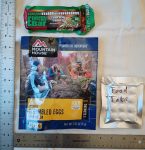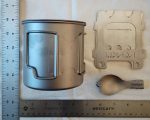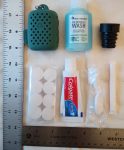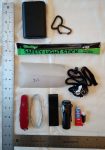(Continued From Part 2.)
Food
This was one of the toughest areas to address – I didn’t want her to have to do things like hunt, fish, trap, or forage on the way, since those take a lot of time and can be very dependent upon the season, but 7 days’ worth of food is heavy and bulky so I proposed an alternate approach for her. Since she takes a suitcase and stays overnight for any trip that’s not immediately local, I recommended that she only keep 3 days’ worth of food in the backpack and bring another 4 days’ worth in her suitcase. That way she’ll have enough in her backpack to get home from any shorter trips without the extra weight and bulk of always carrying a full seven-day supply. If she’s on an overnight trip and has to ‘bug home’ she can ditch her laptop and work tools at the customer site or hotel and replace them with the extra food from her suitcase before heading out.
She has a pretty wide range of tastes in food, and in her own words likes pretty much everything, which simplifies what she should carry. In order to cut down on prep time, I wanted to include non-prep options for breakfast and lunch so the only time she needs to do any cooking or prep is once she’s stopped for the evening. She also mentioned that she frequently gets to her hotel really late when nothing’s open, so she’d like the option of bringing extra meals she can easily prepare in a hotel room.
For the basic load of food, this is what I came up with:
- Breakfast
- Millennium Energy Bar [1] – 3.3 oz., 400 cal.
- Instant coffee packet – .4 oz. (she insisted)
- Tang On The Go packet – .25 oz. (extra vitamins & minerals)
- Day meal
- Survival Tabs [2] (12) – 6.4 oz., 240 cal. (vacuum packed on 4”x 6” mylar bag)
- Alternatively she could go for something like lifeboat rations [3], but those tend to be heavier.
- Dinner
- Freeze-dried meal – 3-5 oz., 400-700 cal.
- Additional lightweight high-energy snacks as desired/available
- Nuts, jerky, chocolate, peanut butter packets, dried fruits, etc.
 [4]Without the snacks a basic daily meal package weighs around 14.35 oz. on average and provides 1040-1350 calories, so three days in her backpack will weight around 2.7 lbs. (43 oz.) In wintertime she’ll probably want to add in some packets of instant oatmeal, hot chocolate, soup, etc. to increase the calorie count. I discussed all of the various options available with her, including how to make her own custom freeze-dried meals [5] by mixing various freeze-dried and instant ingredients (rice, beans, potatoes, meats, veggies, etc.) and vacuum-packing them in mylar bags [6], and she’s started experimenting with different combination of options to see what she likes. Since there are so many different possible options and combinations I’m just going to assume the 14.35 oz. per day weight, which would be 2.7 lbs. (43 oz.) for three days. That brings the total so far up to 8.8 lbs. (141.1 oz.)
[4]Without the snacks a basic daily meal package weighs around 14.35 oz. on average and provides 1040-1350 calories, so three days in her backpack will weight around 2.7 lbs. (43 oz.) In wintertime she’ll probably want to add in some packets of instant oatmeal, hot chocolate, soup, etc. to increase the calorie count. I discussed all of the various options available with her, including how to make her own custom freeze-dried meals [5] by mixing various freeze-dried and instant ingredients (rice, beans, potatoes, meats, veggies, etc.) and vacuum-packing them in mylar bags [6], and she’s started experimenting with different combination of options to see what she likes. Since there are so many different possible options and combinations I’m just going to assume the 14.35 oz. per day weight, which would be 2.7 lbs. (43 oz.) for three days. That brings the total so far up to 8.8 lbs. (141.1 oz.)
Given the rich biodiversity in New England, she’ll probably run across plenty of edible plants in the spring/summer/fall without going out of her way, so I also suggested she learn how to forage by taking a local course [7]. I’ve included a couple of quart-size ziplock baggies in her kit for collecting and carrying extras of anything she finds. As I mentioned earlier I wanted the kit to not rely on any external dependencies, but if she comes across a bush full of ripe raspberries, blueberries, or wild rhubarb there’s no reason she shouldn’t take a minute to enhance her diet.
Since she’ll have meals with her that require boiling water to prepare I included in a small cook set:
- Lixada 4.2″ (Small) Titanium wood stove [8] (2.7 oz.) – This disassembles flat and fits into the same pouch as the fire kit previously discussed.
- Toaks Light Titanium 650ml pot w/lid [9] (2.8 oz.) – For boiling water and making coffee.
- Lixada titanium folding spork [10] (.6 oz.) – For eating.
 [11]The stove uses twigs which are readily available everywhere in New England, and it’s small enough that you can use half of one of the Procamptek tinders discussed earlier to start a fire. I recommended that she use a ziplock baggie to collect dry twigs when they’re available, since it might be pouring rain the next time she needs a fire. The pot fits into one of the side water bottle pockets on the 5.11 backpack with the lid underneath it and the Nalgene water bottle slides inside it nicely. Total weight for the cook set is 6.1 oz., which brings the total up to 9.2 lbs. (147.2 oz.).
[11]The stove uses twigs which are readily available everywhere in New England, and it’s small enough that you can use half of one of the Procamptek tinders discussed earlier to start a fire. I recommended that she use a ziplock baggie to collect dry twigs when they’re available, since it might be pouring rain the next time she needs a fire. The pot fits into one of the side water bottle pockets on the 5.11 backpack with the lid underneath it and the Nalgene water bottle slides inside it nicely. Total weight for the cook set is 6.1 oz., which brings the total up to 9.2 lbs. (147.2 oz.).
She also wanted to be able to prepare some extra meals in her hotel room so I recommended including a small titanium alcohol stove [12] (1.3 oz.) and some alcohol fuel in a small aluminum bottle in her suitcase, since starting any size of wood fire in a hotel room is generally a bad idea. The alcohol stove comes with pot supports so it can be used by itself.
Hygiene
 [13]One thing that she was adamant about is that she’s pretty fastidious when it comes to hygiene, so I included a small module that should get her by for a week. For the guys reading this – female hygiene requirements are different than ours, so before you pass any judgments about this please talk to a female to get her opinion.
[13]One thing that she was adamant about is that she’s pretty fastidious when it comes to hygiene, so I included a small module that should get her by for a week. For the guys reading this – female hygiene requirements are different than ours, so before you pass any judgments about this please talk to a female to get her opinion.
- Culoclean Portable Bidet [14] (.4 oz.) – This is a small top that you can plug into any standard size soda or water bottle full of water for cleaning your private parts. It’s a lot more hygienic and significantly cuts down on the amount of toilet paper required. I strongly recommended that in the wintertime she keeps the squeeze bottle she’s going to use inside her coat to keep it warm until she needs it. Based on personal experience, having freezing cold water hit your exposed private parts is not a pleasant experience.
- 8 x coin towels [15] (.8 oz.) – A couple of drops of water will expand these into a nice sized washed cloth. They can also be re-purposed as toilet paper.
- Toothbrush [16]/Toothpaste [17] (1.3 oz.) – This should be enough for 7 brushings.
- The Doctor’s BrushPicks [18] (.1 oz.) – For cleaning between brushings. They can be re-used a few times if you clean them, and I took 7 and stored them in a sealed section of plastic drinking straw. She already carries these as part of her daily kit.
- Sea-To-Summit Wilderness Wash [19] (1.9 oz.) – A small bottle of liquid soap, good for washing pretty much everything (including you).
- Matador NanoDry Trek Towel [20] (2 oz.) – A small towel for drying off.
- Female Hygiene Products (?)
Total weight is 6.5 oz., so the new total weight is 9.6 lbs. (153.7 oz.).
Tools/Equipment
There are few tools and pieces of equipment that I consider critical for some tasks as well as making emergency repairs to gear and clothing. Having your backpack or poncho tear or getting a hole in your water bottle can have a significant negative impact on your health & safety.
- Victorinox Hiker Swiss army knife [21] (2.7 oz.) – It has all of the standard tools plus a 3” wood saw for cutting firewood, a walking stick, etc.
- 8′ of 1″ Gorilla tape [22] (.5 oz.) – Folded into a flat pack. This stuff is strong and sticks to almost anything.
- 3′ of steel wire (.2 oz.) – This is useful for repairs that the microcord or sewing thread can’t handle.
- Small tube of super glue [23] (DNR) – Another way to make quick repairs. It can also be used for sealing cuts.
- Gear Aid Tenacious Tape patch (silnylon) [24] (.1 oz.) – For repairing the poncho/tarp.
- Small sewing kit (.1 oz.) – This is a couple of sewing needles with thread loaded and wrapped around the needle, then stored inside a sealed section of plastic straw. Because some clothing issues may not be fixable with Gorilla tape.
- Fenix LD15R flashlight [25] (1.7 oz.) – This is the best mix of lumens, size, modes, weight and battery life I could find with a built-in USB charger so she doesn’t have to carry a separate battery charger. It provides a maximum of 500 lumens in Turbo mode, a maximum run time of 100 hours in low and 30 hours with red. It has a nice clip and a magnetic base so it’s easy to attach where you need it.
- Petzl e+LITE 50 (1 oz.) [26] – This is the 50 lumen version and complements the Fenix flashlight by providing hands-free light, which can be critical if you need to perform first aid on yourself in the dark. Since first aid is its critical use case I put it in her medical module bag. It can be stored up to 10 years without any battery drain due to the mechanical lockout switch and provides a maximum of 50 lumens, a runtime of 9 hours on low and 15 hours on red. A spare CR2032 battery can be easily carried wrapped in tape.
- Anker PowerCore 10000mAh Power Bank [27] (6.35 oz.) – I had her replace her old USB battery bank with this one, which should provide enough recharges for her electronics for a 7 day trip (depending on use, of course). She’ll also need a short USB-C charging cable (for her phone) and a USB-C to MicroUSB adapter (to charge the Fenix flashlight). I did a rough power budget analysis and this should provide one full recharge for her phone, the Fenix LD15R flashlight, and one or more additional electronic devices (as discussed later).
- 2 x Small Carabiner [28] (.2 oz.) – These are useful for a lot of different things so I thought I’d add a couple of extra ones.
- 3 x 12 Hour Glow Sticks [29] (2.4 oz.) – These are useful in a lot of emergency scenarios and can save battery life on the flashlights. I recommended she carry one of these in the front outside pocket of her backpack in case she needs quick access to light in an emergency.
 [30]Total weight for this part of the module is .95 lbs. (15.35 oz.), so the new running total is 10.6 lbs. (169.05 oz.) One thing she asked me about was the possibility of adding a solar charger – I told her that I felt the power bank should get her through 7 days with moderate use of her electronics, but if she insisted the lightest solar charger I know of is Solar Paper from Yolk Station [31], which weighs around 5 oz. for the 5W unit. It’s also modular, so you can add additional 2.5W panels on at 2.3 oz. each for up to 15W.
[30]Total weight for this part of the module is .95 lbs. (15.35 oz.), so the new running total is 10.6 lbs. (169.05 oz.) One thing she asked me about was the possibility of adding a solar charger – I told her that I felt the power bank should get her through 7 days with moderate use of her electronics, but if she insisted the lightest solar charger I know of is Solar Paper from Yolk Station [31], which weighs around 5 oz. for the 5W unit. It’s also modular, so you can add additional 2.5W panels on at 2.3 oz. each for up to 15W.
(To be continued, in Part 4.)